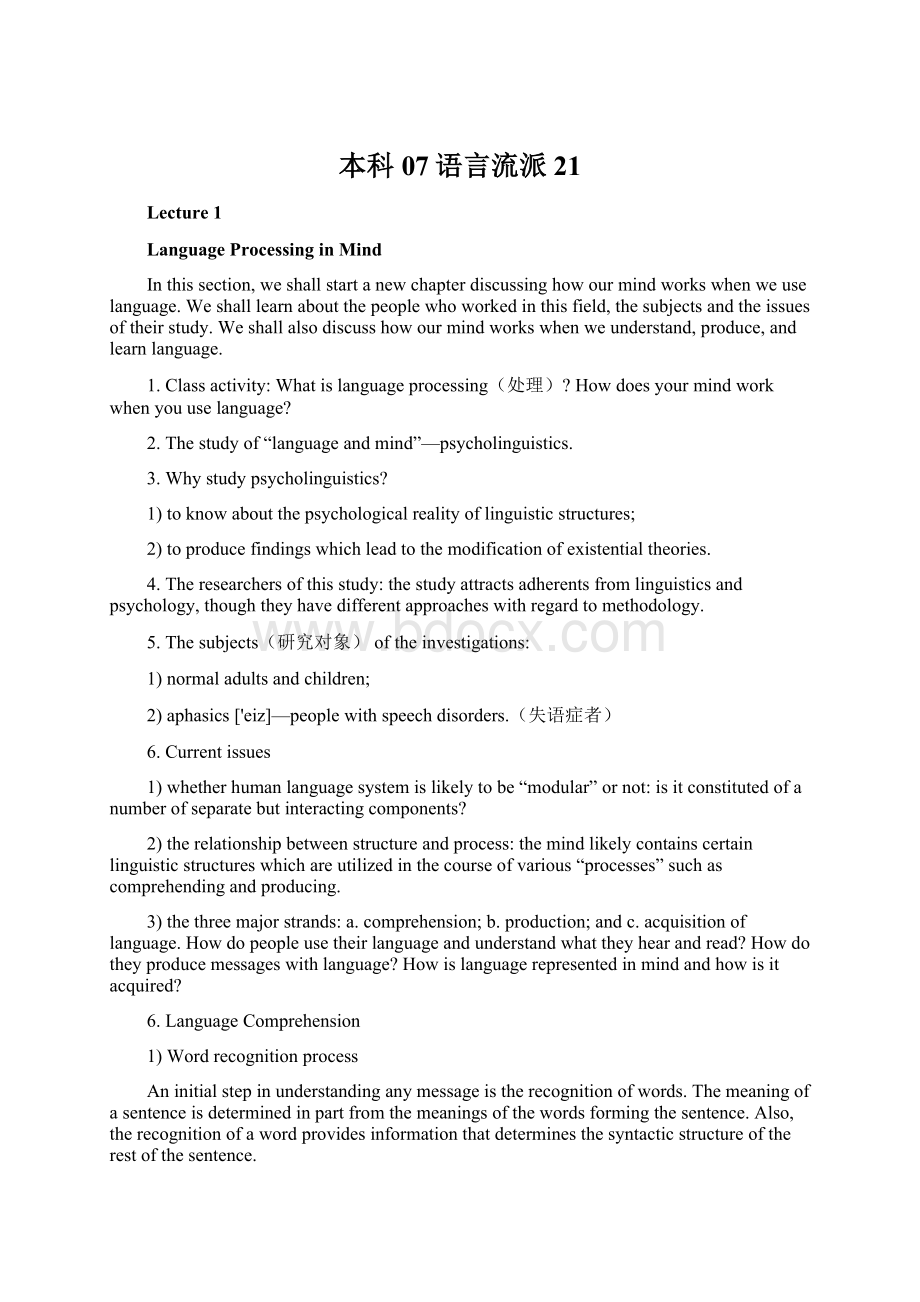本科07语言流派21.docx
《本科07语言流派21.docx》由会员分享,可在线阅读,更多相关《本科07语言流派21.docx(13页珍藏版)》请在冰豆网上搜索。

本科07语言流派21
Lecture1
LanguageProcessinginMind
Inthissection,weshallstartanewchapterdiscussinghowourmindworkswhenweuselanguage.Weshalllearnaboutthepeoplewhoworkedinthisfield,thesubjectsandtheissuesoftheirstudy.Weshallalsodiscusshowourmindworkswhenweunderstand,produce,andlearnlanguage.
1.Classactivity:
Whatislanguageprocessing(处理)?
Howdoesyourmindworkwhenyouuselanguage?
2.Thestudyof“languageandmind”—psycholinguistics.
3.Whystudypsycholinguistics?
1)toknowaboutthepsychologicalrealityoflinguisticstructures;
2)toproducefindingswhichleadtothemodificationofexistentialtheories.
4.Theresearchersofthisstudy:
thestudyattractsadherentsfromlinguisticsandpsychology,thoughtheyhavedifferentapproacheswithregardtomethodology.
5.Thesubjects(研究对象)oftheinvestigations:
1)normaladultsandchildren;
2)aphasics['eiz]—peoplewithspeechdisorders.(失语症者)
6.Currentissues
1)whetherhumanlanguagesystemislikelytobe“modular”ornot:
isitconstitutedofanumberofseparatebutinteractingcomponents?
2)therelationshipbetweenstructureandprocess:
themindlikelycontainscertainlinguisticstructureswhichareutilizedinthecourseofvarious“processes”suchascomprehendingandproducing.
3)thethreemajorstrands:
a.comprehension;b.production;andc.acquisitionoflanguage.Howdopeopleusetheirlanguageandunderstandwhattheyhearandread?
Howdotheyproducemessageswithlanguage?
Howislanguagerepresentedinmindandhowisitacquired?
6.LanguageComprehension
1)Wordrecognitionprocess
Aninitialstepinunderstandinganymessageistherecognitionofwords.Themeaningofasentenceisdeterminedinpartfromthemeaningsofthewordsformingthesentence.Also,therecognitionofawordprovidesinformationthatdeterminesthesyntacticstructureoftherestofthesentence.
Threefactorsaffectingwordrecognition:
a.frequencyofwordoccurrence—frequencyeffect;b.howoftenitisused—recency(临近性)effect;c.context(上下文)effect.
2)Recognizelexicalambiguity
Twomaintheoriesonrecognizinglexicalambiguity:
1)allthemeaningsassociatedwiththewordareaccessed;2)onlyonemeaningisaccessedinitially(soundsmorereasonable).
3)Syntacticprocessing(句法处理)
Aswithlexicalambiguity,insentenceprocessing,therearealsotwoalternativesabouthowpeoplerecognizesyntacticambiguity:
1)peopleeitherconsiderallpossibilitiesanddecidewhichisthebest;or2)theyusesomestrategytodecidewhichstructuretoconsiderfirst.Ifthatstructuredoesnotwork,theymayreconsider.
Eg.“GARDENPATH”sentenceandthecomprehensionofit.“Thehorseracedpastthebarnfell.”
4)Basicprocessesinreading
a.Eyemovement;
b.Perceptionandtheperceptualspan;
c.Immediacyassumption.
7.Discourse/textinterpretation(篇章理解)
1)Notexactlythesameassentencecomprehension.Contexteffectsoccurallthetime.What’smore,weoftennoticethateventhoughwecanreadeverysentenceofapassage,wemaynotunderstandthepassageormakesenseofthewholepassage.
Eg.IlikeEnglish.YoulikeEnglish.WeallliketolearnEnglish.
Eg.IlikeEnglish.YoulikeEnglish.ButwealllearnFrench.
Eg.paragraphsinnovels,proseorpoemsarehardtounderstandorinterpreteddifferentlyfrompeopletopeople.
2)Theinterpretationofdiscourse/text:
(1)Schemataandinferencedrawing
(2)Storystructuring
VanDijkandKintsch(1983)proposed“Macrostructure”(宏观结构)ofastory.
8.LanguageProduction
1)Speechproduction
Garrett(1976)arguedthatspeechproductionisamuchmorecomplexmatterthanitmightappear.Accordingtohismodel,therearefivelevelsofrepresentationinvolvedinspeakingasentence.Yetthisissimpleandsuperficialexplanation.
2)Productionofwrittenlanguage
Writtenlanguageisdifferentfromspokenlanguageinanumberofwaysandisproduceddifferently.Hayes[heiz]andFlower(1986)arguedthatwritingconsistsofthreeinter-relatedprocesses:
planning,thesentencegenerationprocess,therevisionprocess—simpleandsuperficialexplanation.
9.LanguageAcquisition
1)Hotresearchtopictoday.Manyresearcheshavebeendone.
2)InChomsky’sview,wehaveanabstractinnategrammarsysteminourbrain,andsopossesstheabilitytoacquirelanguage.Yet,inacquiringalanguage,social,cultural,personalfactorsarealsoobservedtobeaffecting,esp.inSLA.AlsopeoplefelltoanswerwhySLAisdifferentfromtheacquisitionofone’smothertongue.
10.Homework:
Ex1,4,and7.
Lecture2
LanguageandCulture
Fromthediscussioninclass,thestudentswillgettoknowabouttherelationsbetweenlanguageandculture,thetheoriesrelatedtothestudy,thepeoplecontributedtoit,andalsomanyexamplestheycanfindaroundtosupportwhattheylearn.
1.Classactivities:
What’stherelationbetweenlanguageandculture?
Whydoweneedtostudytheculturewhilelearningalanguage?
Istheuseoflanguageaffectedbycultureandsociety?
How?
2.Therelationbetweenlanguageandculture
Thereexistsacloserelationshipbetweenlanguageandculture.ThisisevidencedbythefindingsfromanthropologistssuchasMalinowski,Firth,Baos,包阿斯Sapir萨皮尔andWhorf沃尔夫.
Thestudyoftherelationbetweenlanguageandthecontextinwhichitisusedistheculturalstudyoflanguage.
1)TheresearchesbyBritishscholars
a.Malinowshi,andhisfindingsfromlanguagesinSoutheastAsia--themeaningofawordgreatlydependsonitsoccurrenceinagivencontext;pavedthewayforacultural,orratheracontextualstudyoflanguage.
b.Firthtriedtosetupamodelforillustratingtherelationbetweenlanguageuseandspeakingsituation.
c.Hallidayandhisfunctionalapproachtogrammar.TheBritishstudyismainlycontextualandfunctional.
2)ThestudiesbyNorthAmericanscholars
a.Boas,Sapir,andWhorf.TheystudiedAmericanIndianlanguagesandrealizedthesignificanceofcultureinthestudyoflanguageuse.
b.Whorf:
proposedaveryinfluentialbutalsoextremelycontroversialtheorybasedonthestudyoftherelationbetweenlanguageandculture—theSapir-WhorfHypotheses,whicharealternativelyreferredtoasLinguisticDeterminism(语言决定论)andLinguisticRelativity(语言相对论).
(1)LinguisticDeterminism:
Languagemaydetermineourthinkingpatterns.(strongversion强式)
(2)LinguisticRelativity:
(weakversion弱式)
i.Similaritybetweenlanguagesisrelative.
ii.Thegreatertheirstructuraldifferentiationis,thediversetheirconceptualizationoftheworldwillbe.
Somepeoplethoughtthatsuchviewreflectsracialdiscrimination.Afterall,thisisaviewfirstexpoundedbytheGerman[e]eth'nologist(人种学家)WilhelmvonHumboldt(冯堡特).
3)Translator’sviewofculture
EugeneNida(尤金·奈达),basedontheexperienceofmanyyearsdevotiontoBibletranslationacrossdifferentlanguagesclaimedfivetypesofsub-culturethatoneshouldbeawareof:
(1)ecologicalculture(eg.thegeographicalsituationfortheBiblewasdifferentfromthatoftoday,andintranslationitshouldbenoticed);
(2)linguisticculture(eg.thelanguagewasnotthesameastheoneweusetoday,thereforeweshouldnotusetoday’slanguagetotranslateancientwritings;
(3)religiousculture(Howdoyoutranslate“真主”intoEnglishfromArabiclanguage?
);
(4)materialculture(HowdoyoutranslateourfoodnamesintoEnglishandEnglishfoodnamesintoourlanguage?
);
(5)socialculture(thesocialpatternisdifferent).Ishalladdonemore—politicalculture.Otherwisehowdoyoutranslateour“五讲四美三热爱”、“三个代表”,etc.
3.Casestudiesoftheculturalrelationtolanguage
Kaplan(开普兰1966)anAmericanteacher,studiedtherelationbetweenstructuralorganizationoftextanddifferentcultures.
Eg.Easternwritingpatterniscircular,Westernpatternisstraight-forward,etc.
Studiesoftheidiomsandmetaphoricalusesshowthatwordsare“idiomatically-governed”and“culturally-specific”.Moreandmorecommonexpressionsbecomeidiomaticormetaphoric.
4.Cultureinlanguageclassroom:
isbeingstressedinlanguageteaching.
5.Homework:
previewnextsection
Lecture3
LanguageandSociety
Inthislecture,weshallfirstofallhaveabriefreviewofthelastlesson.Thentheteacherwillstarttheclassbyaskingquestionsrelatedtothetopicofthislecture.Fromthelecture,theywillgettoknowmoreabouttherelationsbetweenlanguageandsociety.
1.Briefreviewofthelastclass
2.Classactivities:
What’stherelationbetweenlanguageandsociety?
Whydoweneedtostudythesocietywhilelearningalanguage?
3.Therelationbetweenlanguageandsociety
Therelationshipbetweenlanguageandsocietybecameafocusofstudyinthe1960s,alongwiththedevelopmentofsocio-linguisticsasanoppositiontothedominanttheoryofChomskyanlinguisticswhichismonistic(一元的)orautonomous(自足的).
1)Situationalvariationsinlanguage
a.EgsofvariationsinJavaneseindifferentsocialcontext.
b.Lakoff(1991)“Youarewhatyousay.”Histhreebooksonmetaphorare“MetaphorsWeLiveBy”《我们赖以生存的隐喻》(1980,withJohnson),“Women,Fire,andDangerousThings”(1987),and“PhilosophyintheFlesh”Lakoff&Johnson(1999).“Ourwayofthinkingismetaphorical”.
c.Labov’sstudyconcernstherelationbetweenpeople’ssocialstatusandtheirphonologicalvariations/differences.
d.Thestudyofgendereffectsuponone’slinguisticbehaviorbyLakoff(1973)suggeststhatthereexistsawomenregisterinthelanguagethattakesitsownfeatures.
Linguisticsexismreferstolanguageusesthatindicatestatusofdifferentsexinsociety.
2)2socio-linguisticstudies
Socio-linguisticstudyofsociety
Socio-linguisticstudyoflanguage
3)Implication